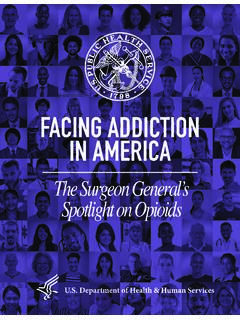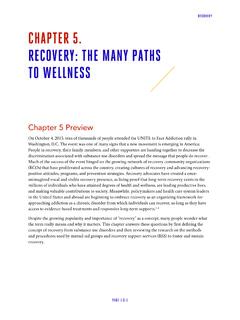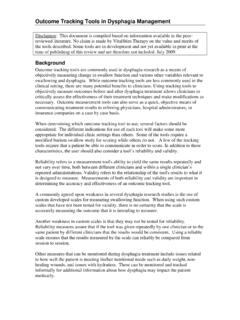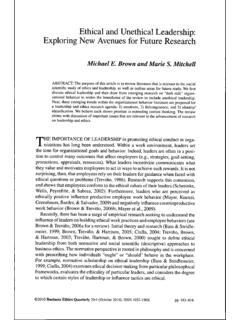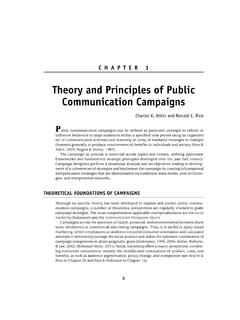Transcription of PREVENTION CHAPTER 3. PREVENTION PROGRAMS AND …
1 PREVENTION PAGE | 3-1 CHAPTER PROGRAMS AND POLICIESC hapter 3 Preview As discussed in earlier chapters, the misuse of alcohol and drugs and substance use disorders has a huge impact on public health in the United States. In 2014, over 43,000 people died from a drug overdose, more than in any previous year on record2 and alcohol misuse accounts for about 88,000 deaths in the United States each year (including 1 in 10 total deaths among working-age adults).4 The yearly economic impact of alcohol misuse and alcohol use disorders is estimated at $249 billion ($ per drink) in 20106 and the impact of illicit drug use and drug use disorders is estimated at $193 billion figures that include both direct and indirect costs related to crime, health, and lost Over half of these alcohol-related deaths and three-quarters of the alcohol-related economic costs were due to binge drinking.
2 In addition, alcohol is involved in about 20 percent of the overdose deaths related to prescription opioid pain Substance misuse is also associated with a wide range of health and social problems, including heart disease, stroke, high blood pressure, various cancers ( , breast cancer), mental disorders, neonatal abstinence syndrome (NAS), driving under the influence (DUI) and other transportation-related injuries,8,9 sexual assault and rape,10,11 unintended pregnancy, sexually transmitted infections,12 intentional and unintentional injuries,13 and property See CHAPTER 4 - Early Intervention, Treatment, and Management of Substance Use the impact of substance misuse on public health and the increased risk for long-term medical consequences, including substance use disorders, it is critical to prevent substance misuse from starting and to identify those who have already begun to misuse substances and intervene early.
3 Evidence-based PREVENTION interventions, carried out before the need for treatment, are critical because they can delay early use and stop the progression from use to problematic use or to a substance use disorder (including its severest form, addiction), all of which are associated with costly individual, social, and public health ,15-17 This CHAPTER will demonstrate that PREVENTION can markedly reduce the burden of disease and related costs. The good news is that there is strong scientific evidence supporting the effectiveness of PREVENTION PROGRAMS and policies. 11 PREVENTION PAGE | 3-2 This CHAPTER uses the term evidence-based interventions (EBIs) to refer to PROGRAMS and policies supported by research.
4 The CHAPTER discusses the predictors of substance use initiation early in life and substance misuse throughout the lifespan, called risk factors, as well as factors that can mitigate those risks, called protective factors. The CHAPTER also includes a system of categorizing PREVENTION strategies defined by the Institute of Medicine (IOM).18 This discussion is followed by a review of rigorous research on substance use initiation and misuse PREVENTION PROGRAMS that have demonstrated evidence of effectiveness . The CHAPTER continues with a review of the rigorous research on the effectiveness and population impact of PREVENTION policies, most of which are associated with alcohol misuse, as there is limited scientific literature on policy interventions for other drugs.
5 Detailed reviews of these PROGRAMS and policies are in Appendix B - Evidence-Based PREVENTION PROGRAMS and Policies. The CHAPTER then describes how communities can build the capacity to implement effective PROGRAMS and policies community wide to prevent substance use and related harms, and concludes with research recommendations. KEY FINDINGS* Well-supported scientific evidence exists for robust predictors (risk and protective factors) of substance use and misuse from birth through adulthood. These predictors show much consistency across gender, race and ethnicity, and income. Well-supported scientific evidence demonstrates that a variety of PREVENTION PROGRAMS and alcohol policies that address these predictors prevent substance initiation, harmful use, and substance use-related problems, and many have been found to be cost-effective.
6 These PROGRAMS and policies are effective at different stages of the lifespan, from infancy to adulthood, suggesting that it is never too early and never too late to prevent substance misuse and related problems. Communities and populations have different levels of risk, protection, and substance use. Well-supported scientific evidence shows that communities are an important organizing force for bringing effective EBIs to scale. To build effective, sustainable PREVENTION across age groups and populations, communities should build cross-sector community coalitions which assess and prioritize local levels of risk and protective factors and substance misuse problems and select and implement evidence-based interventions matched to local priorities.
7 Well-supported scientific evidence shows that federal, state, and community-level policies designed to reduce alcohol availability and increase the costs of alcohol have immediate, positive benefits in reducing drinking and binge drinking, as well as the resulting harms from alcohol misuse, such as motor vehicle crashes and fatalities. There is well-supported scientific evidence that laws targeting alcohol-impaired driving, such as administrative license revocation and lower per se legal blood alcohol limits for adults and persons under the legal drinking age, have helped cut alcohol-related traffic deaths per 100,000 in half since the early 1980s. As yet, insufficient evidence exists of the effects of state policies to reduce inappropriate prescribing of opioid pain medications.
8 *The Centers for Disease Control and PREVENTION (CDC) summarizes strength of evidence as: Well-supported : when evidence is derived from multiple controlled trials or large-scale population studies; Supported : when evidence is derived from rigorous but fewer or smaller trials; and Promising : when evidence is derived from a practical or clinical sense and is widely PAGE | 3-3 Why We Should Care About PreventionBeginning in the twentieth century, the major illnesses leading to death shifted from infectious diseases, such as tuberculosis and infections in newborns, to noncommunicable diseases, such as heart disease, diabetes, and cancer. This shift was a result of effective public health interventions, such as improved sanitation and immunizations that reduced the rate of infectious diseases, as well as increased rates of unhealthy behaviors and lifestyles, including smoking, poor nutrition, physical inactivity, and substance misuse.
9 In fact, behavioral health problems such as substance use, violence, risky driving, mental health problems, and risky sexual activity are now the leading causes of death for those aged 15 to To effectively prevent substance misuse, it is important to understand the nature of the problem, including age of onset. Although people generally start using and misusing substances during adolescence, misuse can begin at any age and can continue to be a problem across the lifespan. As seen in Figure , likelihood of substance use escalates dramatically across adolescence, peaks in a person s twenties, and declines thereafter. For example, the highest prevalence of past month binge drinking and marijuana use occurs at ages 21 and 20, respectively.
10 Other drugs follow similar trajectories, although their use typically begins at a later Early substance misuse, including alcohol misuse, is associated with a greater likelihood of developing a substance use disorder later in ,22 Of those who begin using a substance, the percentage of those who develop a substance use disorder, and the rate at which they develop it, varies by : Past-Month Alcohol Use, Binge Alcohol Use, and Marijuana Use, by Age: Percentages, 2015 National Survey on Drug and Health (NSDUH)Note: Binge alcohol use is defined as drinking five or more drinks (for males) or four or more drinks (for females) on the same occasion ( , at the same time or within a couple of hours of each other) on at least 1 day in the past 30 : Center for Behavioral Health Statistics and Quality, (2016).



